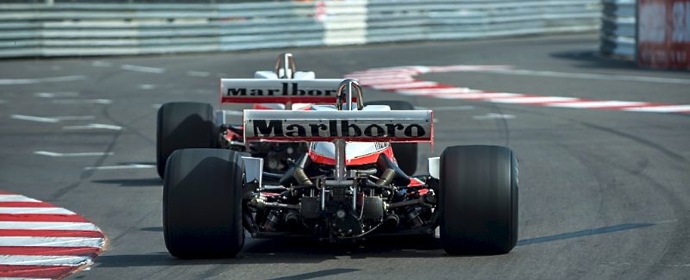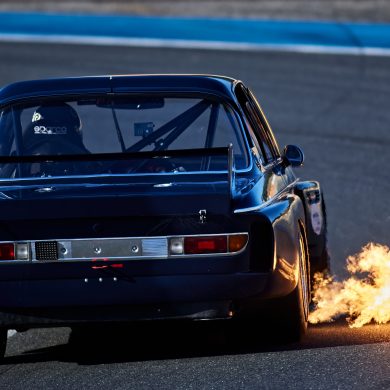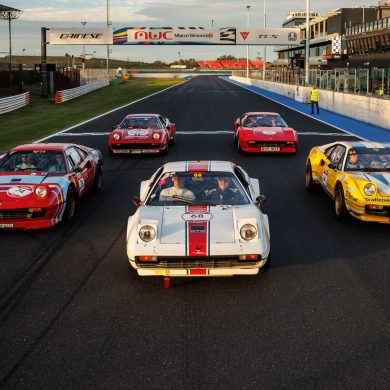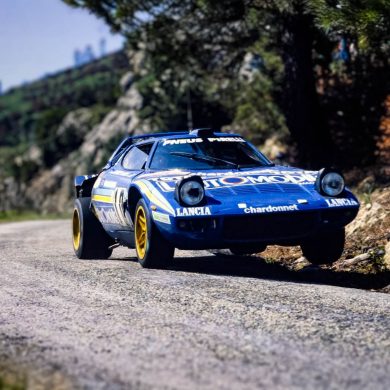Monaco Historic Grand Prix, Circuit de Monaco, May 11-13, 2012
Report and photos by Dirk de Jager
Monaco and Grand Prix: Two names that have been combined since 1929 when Monte Carlo held the first Grand Prix. Since then this famous track has never missed a single year on the calendar. In 1997 the first Historic Grand Prix was held to honour its legends from the past. Now traditionally held biennially two weeks before the current Formula One stars hit the track, the racing is divided into seven grids containing an average of over 30 cars!
The 2012 historic races saw also another change, for the first time the cars where already pouring in for scrutineering on Wednesday and Thursday since they would already start at their first practice sessions on Friday afternoon. Normally all seven grids where supposed to do two practice/qualifying sessions on Saturday, leading to a fairly busy schedule on track, especially when something went wrong. Being Monaco what it is, a very beautiful yet old and twisty track that leaves no room for error. Every driver and owner wants to race at Monte Carlo due to its history, but the downside to it is that damages here are unavoidable! So yellow flags and even red flags are guaranteed every day. But thanks to the swift reactions from the marshals and the good preparations they often tend to clear a car of track in less then 60 seconds. It is usually the clean up and sometimes even the guardrail repair that could eat up the time table. With this year’s new timing this led to longer waits in between sessions but also they stayed on schedule for the first time since all the previous years I’ve attended.
The first grid, Serie A: Grand Prix and Voiturettes from before 1952, saw a gorgeous field ranging from Alfa Romeos, Bugattis, Maseratis and a Talbot-Lago to name a few, yet this field was dominated by the ERA Type Bs. With no less then six of these brutes on track, including the most famous one that belonged to Prince Bira from Siam, it was a treat to see them blast flat out uphill from Saint Devote to Casino.
The second grid B: Grand Prix and F2 from before 1961 showed the period and change over from front engined cars to rear engined cars. The grid for these races were primarily dominated by Cooper and Lotus entrants.
As for Serie C: Sports Cars and Sport Prototypes before 1953, was a refreshing change compared to all the open wheelers that raced around all weekend. Monaco only hosted one sports car race around town in 1952, so most cars are from that year, plus a few older ones. A big part of the grid is filled up with Jaguar C-Types and Frazer Nash Le Mans Replicas, yet the diversity is brought by seeing a Veritas, even a Porsche and a Gordini. Of course Ferrari can’t be missing on the roll call, although this year “only” included a 166 MM and a 225S on track.
The fourth group attends only rear engined F1 cars from 1961 to 1965 and still clearly shows the typical “cigar” lines and pre-era downforce cars. Here again Lotus is considered the top contender for the period.
In Serie E, 3-litre F1 cars from 1966 to 1972, is where you will see the more known form of Formula racing – powerful cars with wings. In this group the real speed starts to show dramatically. Also on the grid there were a bigger mix of cars present. Ranging from Matra, Eagle, Tecno, March, BRM and Surtees to the names that of course can’t be missing such as Ferrari and McLaren. Yet I’m certain that the start of this race will have created some lively debate during that night’s gala dinner. The 4th placed car took a very early jump start and apparently forgot how wide his, and his opponents, rear tyres are. He nicked with his rear the rear of the 2nd place car, jumped over him and managed to snap both of their suspensions, ending the race as soon as the light turned green.
As for the last grid, (G) these were reserved for the Formula 3 cars pre-1985. The Automobile Club de Monaco received so many entries for this segment that they ended up accepting 70 cars!! Also one of the reasons why they started racing on Friday afternoon. A nice change was that since it was for the older cars, so that only one Dallara chassis was present, Dallara has basically dominated this series since they started with F3 in the mid-80s. So seeing different types of Chevron, Martini, March and RALTs in the field gave a good spectacle. It is of course impossible to let loose so many cars in one go on track, so they divided them into two groups, even and odd racing numbers.
With the two groups they let them have their own practice sessions and qualifying race. The top drivers from both heats qualified for their final race on Sunday when they had a chance to race each other with 35 cars. Yet here came some controversy when the 9th place driver tried to cheat a bit and “lined up” more in the middle of the track to have a better chance of passing. The stewards would not have anything of this and aborted the start and placed the car in question to the final spot on the grid. This did mean another warm-up lap and reformation on the grid for a 2nd start. Right when they wanted to light the first light all the yellow flags started to wave since a driver stalled his car and was waving frantically with his arms in the hope that nobody jump started and would hit him from behind. With another aborted start they had to redo the starting procedure again and finally after a third try they managed to get away. Even during the race several cars dropped out and in the end they where flagged off behind the safety car.
The highlight of the weekend was the last race, Serie F: 3-litre Formula One cars from 1973 to 1978. The big boys everybody had been waiting for almost became an anticlimactic when right after the previous F3 race there came a torrential downpour flooding the track. This meant that luckily the race was only delayed for about 40 minutes before the track was drivable again with just a slight dripping rain that came on and off. This was a huge contrast compared to the two previous days with nothing but sunshine and warm weather. Yet for the brave spectators that weathered through the storm front this was pure heaven to watch. Seeing 32 Formula One cars taking a wet track boosting off big sprays of water made it very difficult for the following drivers to see anything. Several drivers where clearly pushing their limits in these difficult circumstances as was very clear when they kept correcting their steeds coming round the chicane in the harbour or even just missing that one. Luckily everybody stayed on track and must have had a blast going around these tight streets and giving it all their best.
All and all, the 2012 Monaco Historic Grand Prix treated spectators to some active and exciting racing with, as Monaco has gotten to be known for, several damaged cars and more bruised ego’s then you can count. Over the entire weekend the atmosphere remained thrilling and exciting, which shows a clear interest from both attendees and entrants to mark their calendars to return in two years time!
Monaco Historic Grand Prix 2012 – Photo Gallery (click image for larger picture and description)
[nggallery id=404 images=15]
[Source: Dirk de Jager]











Was the writer of this report actually at or even watching the Monaco races because the report is a pure work of fiction. In race F for example at least 6 cars failed to finish due to crashes.!!
That’s very simple Judy
When i’m track side i have no access to a tv or the big screens pointed to the grandstands
so all i see is what happens at the corner(s) where i am at at that moment
that means as far as i know i didn’t see a single crash happening during that race, i saw after the race 2 cars coming by on flatbeds without damage to them, so then i can assume there was a technical problem
and at my spot i saw them only miss the chicane and sliding around
nobody hitted each other there or went into the wall
and this year was probably the most clean year of racing i have seen there since i’ve attended since 2004
I remember for instance in 2008 that was the worst year for crashes, this time a lot cleaner racing and fighting with less safety cars, crashes, etc.. then previous years
Is this event only held every two years?
The report was a little colored no doubt but I was there for the three days and loved every moment of the time the cars were on the track. I admit I did tire of watching the modern Cadillac doing its demo runs and admit I hoped it might find a patch of oil around Tabac. The cars racing that weekend were the hero cars of my youth and the trip from Australia to see these priceless cars was worth every cent. The crowd, the track, the cars – all so special. Given Monaco’s intimidating nature I was surprised at how hard some of the cars were punted, especially the leading bunch. Those sounds will long remain with me. Pure magic. We are so lucky that the owners of these iconic cars put them in harm’s way for our enjoyment. And yes there were more cars returning to the pits on the back of trucks than I expected, but they were racing after all. Thank you to all concerned.
While I was there on Sunday and saw all the races from the stands, even in the rain, and I experienced the atmosphere in the paddock with all the cars lined up and the mechanics at work and gentleman drivers.
I’m excited for the pre-war Alfa Romeo, the 60 year F1, Tecno, the 6-wheel Tyrrell and many Ferrari in the race.
I had never been in Monaco for the GP but this time goes for all the years in front of the TV!
Luigi, I salute you!
Some really nice pictures!
But you`d better not work so much with photoshop or ather programmes because most of the pictures are to dark and with a vignette, that disturbes also the good pictures.
Anyhow, good pictues and you are a lucky man to got the chance to be there with an accrediation letter…